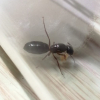Is there a difference between O. smaragdina and O. longinoda besides distribution and color?
- Formiculture.com
- Forums
- Gallery
- Members
- Member Map
- Chat

Is there a difference between O. smaragdina and O. longinoda besides distribution and color?
7 months later and no reply, does no one really know?
Edited by T.C., December 1 2022 - 6:25 AM.
I don't know about O.smaragdina but O.longinoda yes,they are native to where i live (west africa).They are predetory ants,lives in trees(especially mango's and citrus trees).The queens are monoginy,brown in colour.they mate with several male in the air or on low vegetation.the workers have two castes,minor and major.What other information do you need?
The difference between O. smaragdina and O. longinoda, there has to be a difference since the African O.longinoda used to be O. smaragdina until it got changed.
Is there a difference between O. smaragdina and O. longinoda besides distribution and color?
Abstract--
l. A comparison of the volatile exocrine secretions of Oecophylla smaragdina with published results on O. longinoda shows the two species are very similar.
2. The contents of Dufour glands of both major and minor workers are closely similar, with undecane the major substance in both castes of both species.
3. The mandibular glands were distinctly different, both between major and minor workers of O. smaragdina and between major workers of the two species. Major workers' mandibular glands contain chiefly hexyl hexanoate, 3-decanone and octyl hexanoate while minor workers contain nerol and 1-nonanol.
4. Males' mandibular glands contain chiefly 3-dodecanone, 3-decanone and 3-decanol, which is very different from the mixture of carboxylic acids in the heads of males of O. Ionginoda.
https://bio.kuleuven..._oecophylla.pdf
Wants (Please reach out if you have them for sale if you’re in the US): Acromyrmex Sp., Atta Sp., Cephalotes Sp., Myrmecocystus Sp (Prefer Mexicanus), Odontomachus Sp. (Prefer Desertorum), Pachycondyla Sp., Pheidole Sp (Prefer Rhea. The bigger the better. Not the tiny bicarinata), Pogonomyrmex Sp (Prefer Badius)., Pseudomyrmex Sp. (Prefer the cute yellow ones)
More on o.longinoda.they feed on insects like fruit fly,caterpillers,spiders etc.they tend on aphids and scaly bugs.they also get their sugars from the extra floral nectaries their host plant produce.
That's...pretty much the same diet as O. smaragdina.
Please any information about o.smaragdina? because i think i'm wasting my time.
They are pretty much the exact same to each other besides a few differences aznphenom said. The most obvious difference is that they live on different continents and their color range is different. O. smaragdina can range from bright red to brown to bright green and orange. O. longinoda can range from bright red to dark red to brown and even black.
Please any information about o.smaragdina? because i think i'm wasting my time.
They are pretty much the exact same to each other besides a few differences aznphenom said. The most obvious difference is that they live on different continents and their color range is different. O. smaragdina can range from bright red to brown to bright green and orange. O. longinoda can range from bright red to dark red to brown and even black.
I'm pretty sure there was a study on founding O. longinoda queens, and there were huge pleometrotic groups found in large seeds. O. smaragdina usually founds alone or in small groups that later lead to oligogyny. Not sure if I'm correct though. That's one difference I was able to find. I also think coloration in queens in different, since most O. smaragdina queens are lighter in color.
0 members, 1 guests, 0 anonymous users